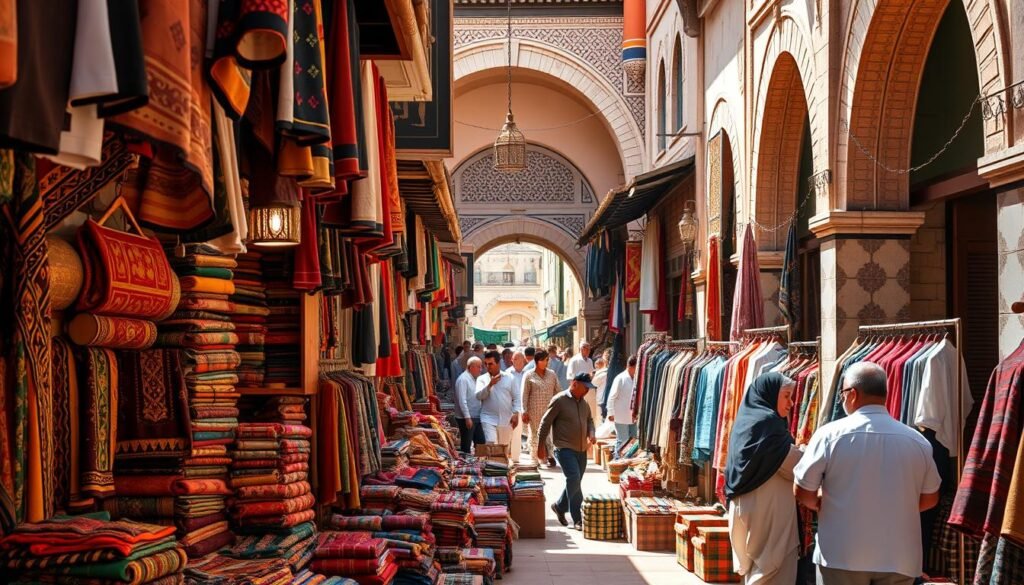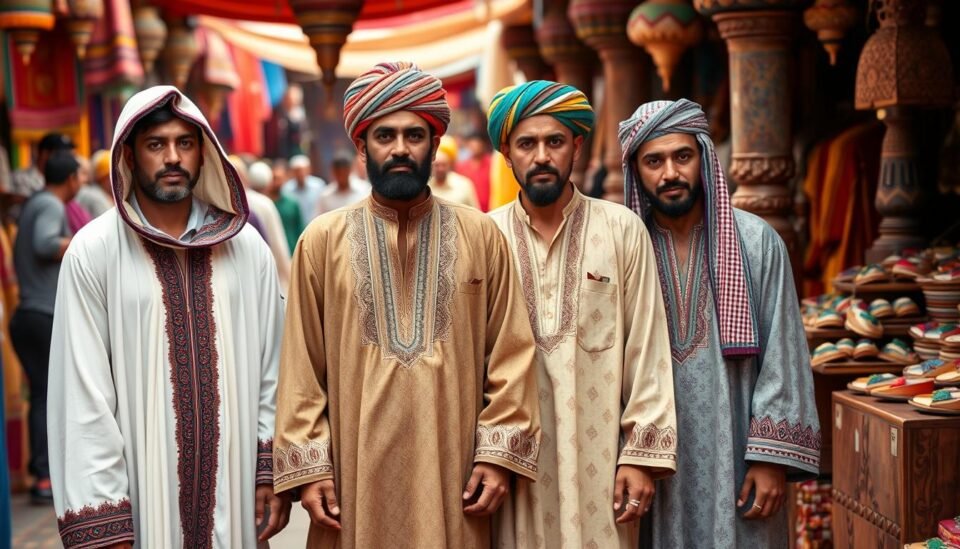Dive into the world of Moroccan men’s fashion. It’s all about comfort, style, and culture. The authentic Moroccan garments like the djellaba and kaftan are truly special. They show the lasting beauty of traditional men’s clothing in the Maghreb.
Discover the world of Moroccan fashion heritage. See how these classic designs still wow people today.
Learn about the special details and meanings of these authentic Moroccan garments. Find out the stories and artistry in each piece. See why Moroccan men’s clothing is so unique and loved for so long.
Overview of Moroccan Men’s Clothing
Moroccan men’s fashion is a mix of old and new. It shows the country’s deep culture. The djellaba and takchita are key pieces, showing Morocco’s style.
Men’s fashion in Morocco is more than looks. It shows the nation’s lasting culture. The djellaba, for example, means a lot. It shows status, religion, and where you’re from.
As Morocco changes, so does its men’s fashion. Old styles stay, but new ones come too. This makes men’s fashion in Morocco exciting and full of life.
Types of Traditional Moroccan Garments
Traditional Moroccan men’s clothing has a few standout pieces. The djellaba is a long, loose robe with a hood. It’s worn daily or for special events, showing both comfort and cultural value.
The gandora is a long, straight tunic with fancy embroidery or patterns. It’s a favorite among many.
The kaftan is for formal events and ceremonies. It’s known for its flowing design and fancy details. This shows the rich fashion heritage of Morocco.
These traditional robes have changed over time but kept their cultural feel. The djellaba, gandora, and kaftan are still loved today. They show the lasting beauty of Moroccan fashion.
Fabrics and Materials Used
Moroccan men’s clothing is famous for its quality and natural materials. The heart of this tradition is the beautiful Moroccan textiles. These are made with care by local artisans.
These fabrics range from soft wool to luxurious silk. They bring the bright colors and detailed patterns of Moroccan fashion to life.
Handwoven fabrics are a big part of Moroccan clothing. These skills have been passed down for many generations. Cotton is used for everyday clothes because it’s breathable.
Silk, with its shiny look, is for special occasions. Using natural fibers adds elegance to Moroccan clothes. It also shows respect for the land and resources.
The colors and patterns in Moroccan textiles mean a lot. Colors like saffron and indigo come from local dyes. Each color has its own story.
Geometric and calligraphic designs show the area’s rich art. They show the creativity and skill of Moroccan artisans.
Cultural Impact on Moroccan Men’s Fashion
The traditional Moroccan men’s fashion is deeply rooted in the country’s rich cultural heritage. Religious, social, and regional factors have all played a significant role in shaping the clothing choices of Moroccan men over the centuries. From the iconic Djellaba to the sophisticated Caftan, traditional Moroccan dress customs serve as a powerful symbol of cultural identity.
The influence of Islamic traditions, particularly the emphasis on modesty and elegance, can be seen in the tailored silhouettes and intricate embroidery that adorn traditional Moroccan garments. Similarly, the country’s diverse regional influences, ranging from the Andalusian to the Ottoman, have contributed to the rich tapestry of Moroccan fashion influence over the centuries.
Today, modern Moroccan men continue to strike a balance between traditional attire and contemporary fashion trends. They seamlessly blend the old and the new. This commitment to preserving cultural identity while embracing the evolving nature of Moroccan fashion is a testament to the enduring power of the country’s sartorial heritage.
How to Style Moroccan Men’s Clothing
Styling Moroccan men’s clothing is all about mixing old and new. Moroccan fashion is full of cultural stories. But it also fits well with today’s styles. Here are some tips to make Moroccan clothes your own.
Begin by mixing a traditional djellaba or Kaftan with modern pants and a clean shirt. This mix of old and new looks great for any event. Add a cool leather belt or Moroccan slippers for that special touch.
For a laid-back look, layer a Moroccan vest or jacket over a tee and jeans. The unique fabrics and designs add a lot to your outfit. Try mixing old and new pieces to show off your style.
For different weather, choose light fabrics like cotton or linen. They keep you cool and comfy, even when it’s hot. With the right style and accessories, you can wear Moroccan fashion every day. It shows your love for tradition and modern style.
Where to Find Authentic Moroccan Men’s Clothing
Looking for authentic Moroccan men’s clothing? It’s a great way to dive into Morocco’s rich culture. You can find it for yourself or as a special gift. There are many places to check out.
Traditional markets, or souks, in Morocco are perfect. They are full of skilled artisans and local sellers. They have everything from djellabas to kaftans. Visiting these markets lets you feel the local culture.

Can’t go to Morocco? No worries. Online Moroccan retailers have authentic men’s clothing too. They work with Moroccan makers to ensure quality. Always check the seller’s reputation and read reviews online.
Buying Moroccan clothing, whether in person or online, requires some knowledge. Look for traditional fabrics, detailed embroidery, and unique shapes. This way, you’ll know you’re getting real Moroccan pieces.
Care and Maintenance of Moroccan Garments
Keeping traditional Moroccan garments beautiful needs care. If you have a Moroccan Gandora or other special item, cleaning and storing it right is key. This keeps these cultural treasures looking great.
Cleaning Moroccan clothes needs to be done with care. Hand-washing with mild soap and cool water is best. Machine washing can hurt the embroidery or patterns. Dry them in the shade to stop colors from fading.
Ironing or steaming should be done carefully. This helps keep the fabric in good shape.
Storing Moroccan clothes also needs attention. Use special folding, acid-free tissue, and keep it in a cool, dry spot. This keeps colors bright and prevents damage. Fixing stains or small repairs quickly is also important. It helps the garment last longer and stay meaningful.
